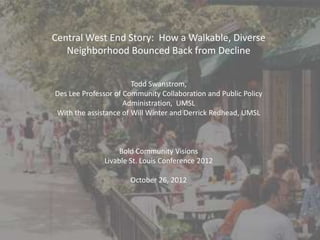
How a Walkable Urban Neighborhood in St. Louis Bounced Back from Decline
- 1. Central West End Story: How a Walkable, Diverse Neighborhood Bounced Back from Decline Todd Swanstrom, Des Lee Professor of Community Collaboration and Public Policy Administration, UMSL With the assistance of Will Winter and Derrick Redhead, UMSL Bold Community Visions Livable St. Louis Conference 2012 October 26, 2012
- 2. Questions 1. How has the CWE changed over time (upward or downward trajectory)? 2. How does the CWE compare to the City of St. Louis (convergence or divergence)? 3. Is the CWE a classic case of “gentrification? 4. What were the main forces shaping the development of the CWE (private market, public policies, civil society)?
- 3. Mapping Change: Census Tracts and the CWE
- 4. Change in Population by Census Year: 1970-2010* 120 100 80 Central West End 60 St. Louis City 40 20 0 1970 1980 1990 2000 2010 * 1970 = 100 US Census Bureau
- 5. Change in Number of Households by Census Year: 1970-2010* 120 100 80 Central West End 60 St. Louis City 40 20 0 1970 1980 1990 2000 2010 US Census Bureau * 1970 = 100
- 6. Vacant Housing Units as a Percent of All Units: 1970-2010 25% 20% 15% Central West End St. Louis City 10% 5% Source: US Census Bureau 0% 1970 1980 1990 2000 2010
- 7. Change in Median Housing Values: 1970-2010 $300,000 $250,000 $200,000 Central West End St. Louis City $150,000 $100,000 $50,000 Source: US Census Bureau $0 1970 1980 1990 2000 2010
- 8. Average (Gross) Monthly Rent in 2011 Dollars: 1970-2010 $900 $800 $700 $600 $500 Central West End St. Louis City $400 $300 $200 Sources: US Census Bureau & $100 Bureau of Labor Statistics $0 1970 1980 1990 2000 2010
- 11. Is the CWE a classic case of “gentrification? 1. Average income goes up as “gentry” (YUPPIES) move in. 2. Average family size decreases (more young singles and “empty nesters”). 3. Low-income, working class, and minority residents are displaced by rising rents and house prices. 4. A heterogeneous neighborhood is transformed into a homogenous community with a suburban cultural feel.
- 12. Average Family Incomes in 2011 Dollars: 1970-2010 $100,000 $90,000 $80,000 $70,000 $60,000 Central West End St. Louis City $50,000 $40,000 $30,000 $20,000 $10,000 Sources: US Census Bureau & Bureau of Labor Statistics $0 1970 1980 1990 2000 2010
- 13. Percent of Families Living in Poverty: 1970-2010 25% 20% 15% Central West End St. Louis City 10% 5% 0% 1970 1980 1990 2000 2010 US Census Bureau
- 14. Nonfamily Households as Percent of all Households: 1980-2010 80% 70% 60% 50% Central West End St. Louis City 40% 30% 20% 10% 0% US Census Bureau 1980 1990 2000 2010
- 15. Distribution of Population by Age: Central West End vs St. Louis City 1970 60.0% 50.0% 40.0% Central West End St. Louis City 30.0% 20.0% 10.0% 0.0% Under 18 years 18 to 34 years 35 to 64 years 65 and over Source: US Census Bureau
- 16. Distribution of Population by Age: Central West End vs St. Louis City 2010 60.00% 50.00% 40.00% Central West End 30.00% St. Louis City 20.00% 10.00% 0.00% Under 18 years 18 to 34 years 35 to 64 years 65 and over Source: US Census Bureau
- 17. Population by Race in the Central West End: 1970-2010 20,000 18,000 16,000 14,000 12,000 White Black 10,000 Hispanic & Latino 8,000 6,000 4,000 2,000 Source: US Census Bureau - 1970 1980 1990 2000 2010
- 18. CWE has all the characteristics of a gentrified neighborhood … …but… It is still racially and economically diverse.
- 19. Racial/Ethnic Com 3% 11% White African American 28% Asian 58% Other
